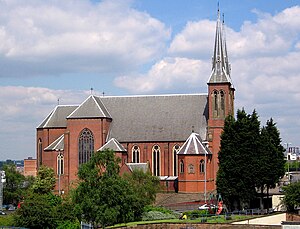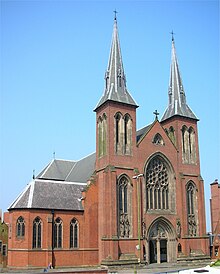St. Chad's Cathedral
The Birmingham Cathedral ( The Metropolitan Cathedral and Basilica of Saint Chad or St Chad's Cathedral ), the mother church of the Roman Catholic Archdiocese of Birmingham in the English city of Birmingham . It is dedicated to Saint Chad , who was Bishop of York in the 7th century . The church was designed by Augustus Welby Northmore Pugin and essentially completed in 1841. It was given the status of a cathedral in 1850 and, along with Downside Abbey and the Basilica of Our Lady of Walsingham, is one of only three Basilicae minores in England. This makes St. Chad's the first Roman Catholic cathedral to be built in England after the Reformation .
history
St. Chad's Church was built at the instigation of the local Vicar Apostolic and Bishop Thomas Walsh. It was planned as a cathedral church from the start. The foundation stone was laid in October 1839. The church was founded on June 21, 1841 consecrated . The official elevation to the cathedral was not made until 1850 by Pope Pius IX. because it was only at this point in time that the Catholic dioceses in England were re-established . Finally, in 1911, the Diocese of Birmingham became an archdiocese.
In the cathedral, the relics of the patron of the church are kept in the ciborium above the altar . They are some long bones of St. Chad. These were originally housed in Lichfield Cathedral and were saved from pillage during the Reformation by the benefactor Arthur Dudley around 1538 . Dudley passed the relics on to his nieces, who passed them on with their families. These did not reappear until 1651, when the farmer Henry Hodgetts died and told the priest about it on his deathbed. The priest took the relics and took them to St. Omer's seminary in northern France. In the 19th century, the relics came from there via Aston Hall to Bishop Walsh, who was just deciding which patron should be given to his new cathedral. So it came about that the relics of the saint, who was the apostle of the Midlands in the seventh century, were deposited over the altar. Birmingham Cathedral is the only cathedral in England to have the patron saint's relics above the altar. Investigations of the relics by the archaeological laboratory at Oxford University in 1985 revealed that all but one bone actually date from the 7th century and thus from the time of St. Chad.
In 1941 the cathedral was opened by Pope Pius XII. declared as a church with significant historical connections to the Minor Basilica. Since then, the Tintinnabulum and the Padiglione have been presented on the steps of the altar as symbols for such a basilica on official occasions .
Architecture and equipment
St. Chad's was designed by the English architect Augustus Welby Pugin (1812-1852), one of the most important neo-Gothic architects. The cathedral was his first major church building.
St. Chad's replaced a smaller church that had been built on the same site in 1808. Due to the local conditions and since brick had to be used as the main building material , there were restrictions in the design of the church. Bath Stone could only be used for details such as tracery and door frames . Since Pugin wanted the interior to be as open and spacious as possible, he oriented himself stylistically on the German brick Gothic and chose the hall church type . The westwork was given a double tower facade with narrow towers similar to those of Lübeck Cathedral . A higher tower that he had planned to balance the overall proportions of the exterior structure as a crossing tower was unfortunately not implemented. In view of the steep slope of the building site to the east, Pugin planned a large crypt under the building , which was primarily intended to be used as a burial place for parishioners and clergy and is now used as a rehearsal room for the choir.
Inside, the nave is almost twice as high as it is wide. Typical of a hall church, it has very high arcades supported by thin pillars . These are decorated in the sanctuary with colored and golden leaves and a helical pattern and bear the inscription Sanctus Sanctus Sanctus Dominus Deus Sabaoth ("Holy, Holy, Holy, Lord, God of hosts"). The wooden ceiling with the curved, blue-painted roof truss is decorated with monograms and floral patterns, as can also be found on the old ceilings of the cathedrals of Ely and Peterborough.
Pugin designed the interior partly himself. He designed a high altar under an elaborately worked ciborium and the bishop's chair made of oak, which is upholstered with green velvet and bears the coat of arms of the diocese. One of the most typical works of his style was the rood screen , which is no longer in the church (see below). Other furnishings such as the 16th century pulpit and medieval choir stalls come from various churches in Belgium and Germany and were collected and donated by the sixteenth Earl of Shrewsbury John Talbot.
The stained glass windows in the church choir are the work of William Warrington . Other windows, metalwork, furniture and drapery were made by the Birmingham- based John Hardman company . Hardman was a parishioner of St. Chad's and founded the cathedral's choir community in 1854 . Four generations of his family are buried in the crypt.
In 1932, St Chad's was expanded to include St Edward's Chapel , designed by Pugin's grandson Sebastian Pugin Powell . The name of the chapel is intended to remember the first Archbishop Edward Ilsley and his patron saint Eduard the Confessor . The chapel windows tell the story of the relics of St. Chad and those who served the Church. It also shows some great church coats of arms. In the 1960s a number of items were removed from the interior and the interior was repainted without reference to the original design. Pugin's rood screen was given to the Anglican Church of the Holy Trinity in Reading, and other items of equipment went to other churches.
organ
The organ was built in 1968 by the organ builder Nicholson and reorganized and renewed in 1993 by the organ builder Walker. The instrument has 40 registers on three manuals and a pedal . The stop actions are electric.
|
|
|
|
||||||||||||||||||||||||||||||||||||||||||||||||||||||||||||||||||||||||||||||||||||||||||||||||||||||||||||||||||||||||||||||||||||||||||||
Individual evidence
- ↑ Augustus Pugin: The Present State of Ecclesiastical Architecture in England and Some Remarks Relative to Ecclesiastical Architecture and Decoration, Dolman, London 1840, reprinted by Gracewing Publishing 2004, page 1 ( online in the Google book search)
- ^ Roderick O'Donnell: The Pugins and the Catholic Midlands by Rory. Gracewing, 2002, p. 18
- ↑ a b History on the website of the cathedral ( Memento from July 11, 2013 in the Internet Archive )
- ↑ information on organ (English)
Web links
Coordinates: 52 ° 29 '8.3 " N , 1 ° 53' 55.5" W.

